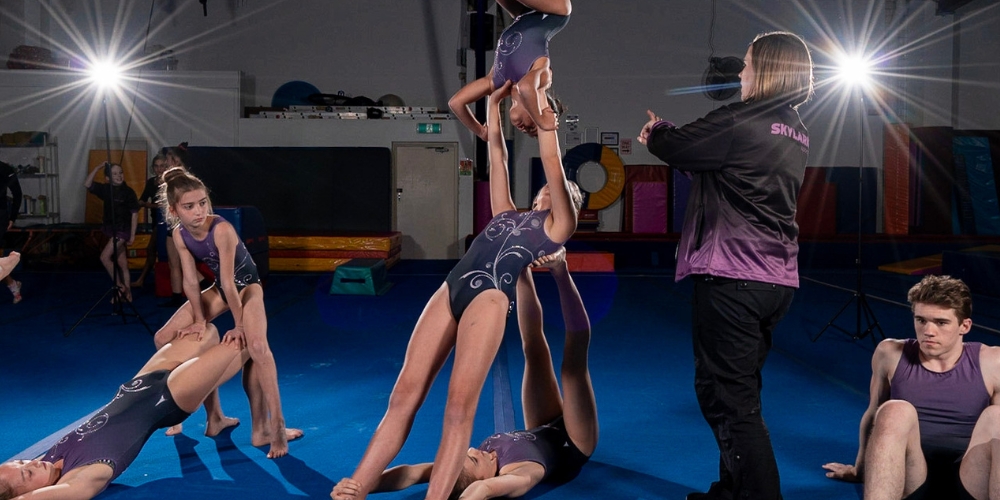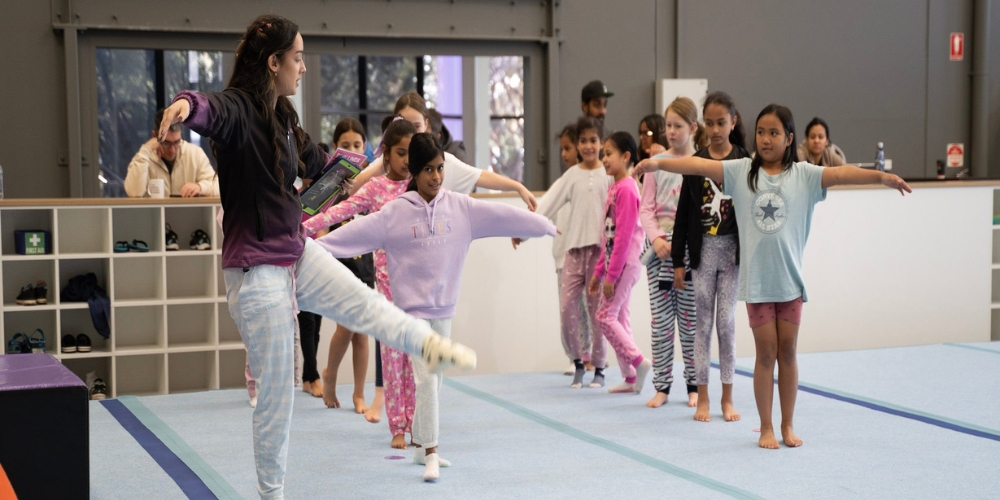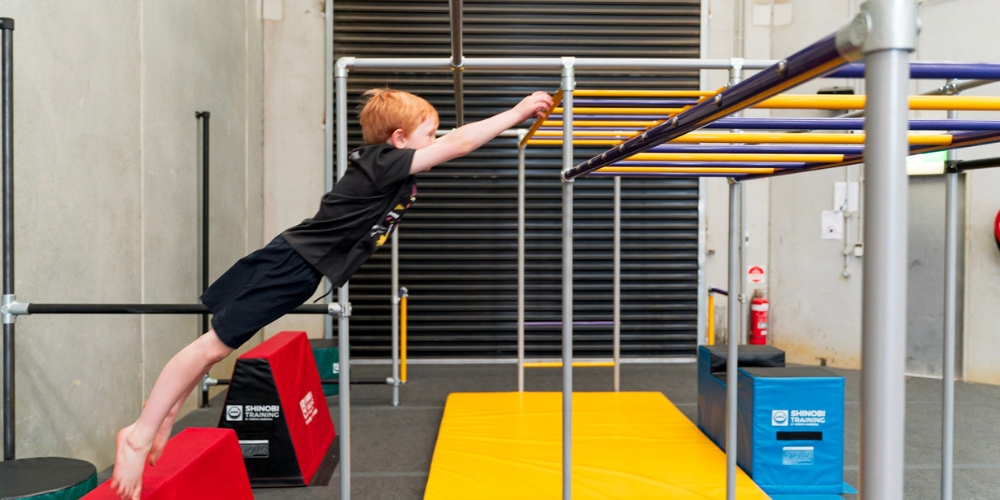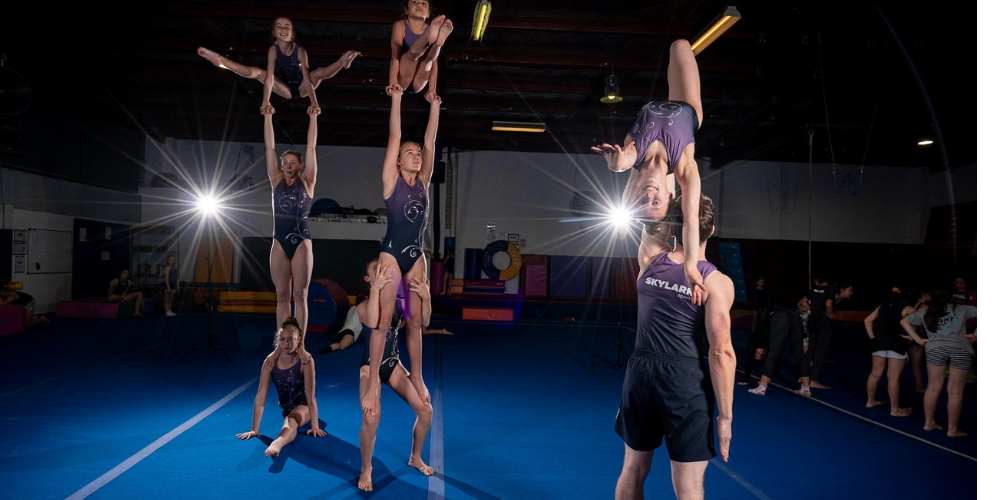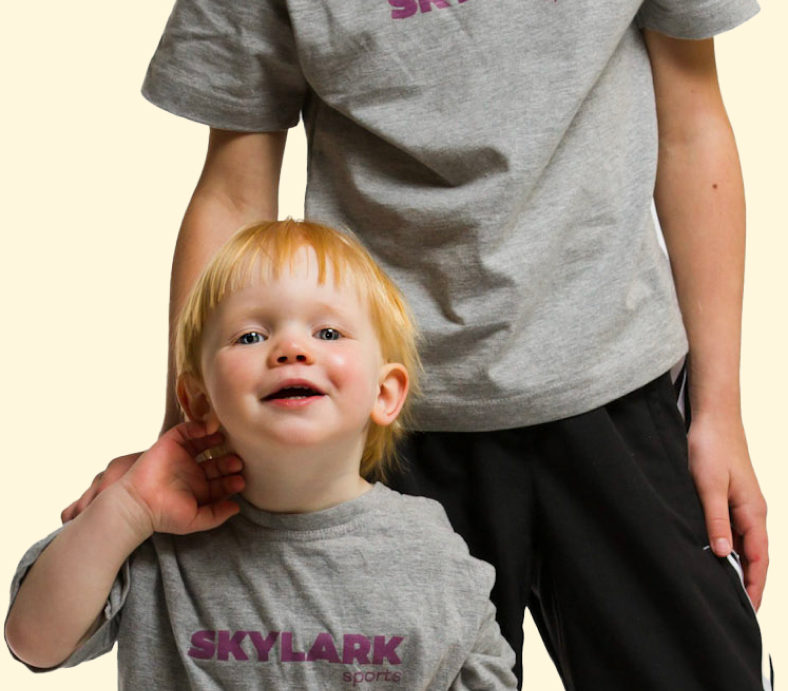Strength training isn't just about pumping iron or getting swole (although that's a cool bonus). It's about giving your body the power to perform at its peak. Think of it like fuelling up a race car—you wouldn't expect it to win without a powerful engine under the bonnet.
In gymnastics, strength is the engine that drives everything else. It helps you leap higher, swing faster, and confidently stick to those landings. Plus, it's like a safety net, reducing your risk of injury by supporting your joints and stabilising your movements.
Gymnast Strength Training Routines
As a gymnastics trainer with years of experience, I've witnessed firsthand the importance of core strength for gymnasts. It's about having a six-pack and building a solid foundation for every move.
I often see gymnasts need help to maintain proper form during handstands or to execute clean tucks and layouts. More often than not, it comes down to needing more core stability. That's why I always emphasise core-focused exercises in our training sessions.
One of my favourite drills is the hollow hold. It's a simple yet effective exercise that teaches gymnasts to engage their core muscles while maintaining a straight body position—a skill essential for mastering various gymnastics elements. I've seen remarkable improvements in my students' overall performance after incorporating hollow holds into their routines.
Upper Body Strength
When it comes to upper body strength, I've found that many gymnasts underestimate its importance. But as any seasoned gymnast will tell you, strong arms and shoulders are essential for executing those picture-perfect handstands and powerful swings on the bars.
I remember working with a young gymnast who struggled with her handstand on the balance beam. No matter how hard she tried, she couldn't hold the position for more than a few seconds. After implementing a structured upper body strength training routine—including exercises like press-ups and pull-ups—her handstand improved dramatically within just a few weeks.
Leg Day
Leg strength is often overlooked in gymnastics, but it's vital for generating power and stability during jumps, leaps, and landings. As a trainer, I include plenty of leg-focused exercises in our workouts to help gymnasts develop the strength and endurance needed to excel in their routines.
Flexibility and Mobility
In the fast-paced world of gymnastics, flexibility and mobility often take a backseat to strength training. However, as a trainer, I know firsthand how crucial they are for preventing injuries and maximising performance.
I've seen countless gymnasts sidelined by injuries simply because they neglected their flexibility and mobility. I always emphasise incorporating stretching and mobility exercises into our training sessions.
At What Age Should Gymnasts Start Incorporating Strength Training Into Their Routines?
Determining the right age to start incorporating strength training into a gymnast's routine is a question I get asked often as a trainer. While there's no one-size-fits-all answer, some important factors must be considered.
Generally, I recommend introducing basic strength exercises to gymnasts around the age of 7 or 8, provided they have a solid foundation in gymnastics fundamentals and proper technique. At this age, children are typically more coordinated and able to follow instructions, making it a suitable time to begin building strength in a safe and controlled manner.
However, it's important to approach strength training with caution and tailor it to each gymnast's individual needs and abilities. Younger gymnasts should focus on bodyweight exercises, balance, and coordination drills rather than heavy weights or intense resistance training to avoid placing undue stress on developing muscles and joints.
As gymnasts progress in age and skill level, their strength training routines can gradually become more advanced, incorporating resistance bands, light weights, and additional exercises to target specific muscle groups relevant to their discipline.
Ultimately, the key is prioritising proper form, safety, and gradual progression when introducing strength training to gymnasts of any age. Consulting with a qualified gymnastics coach or trainer can help ensure that strength training is integrated effectively and safely into a gymnast's overall training regimen.
Equipment Used in Gymnastics Strength Training
You don't need fancy equipment or a high-tech gym to get results when it comes to gymnastics strength training. Some of the most effective exercises can be done using simple equipment you can access. Here are a few key pieces of equipment commonly used in gymnastics strength training:
Gymnastics Rings
Gymnastics rings are versatile tools that can be used to target upper body and core strength, as well as balance and stability. Ring exercises like ring dips, ring rows, and ring press-ups require immense strength and coordination, making them ideal for gymnasts to level up their skills.
Pull-Up Bar
A pull-up bar is a staple in any gymnastics gym. It's perfect for building upper body strength and mastering skills like pull-ups, chin-ups, and leg raises. Plus, it's portable and easily installed in most doorframes, making it accessible for home workouts.
Foam Mats
Foam mats provide a supportive surface for gymnasts to practice exercises and drills safely. Whether you're working on handstands, cartwheels, or tumbling passes, foam mats help cushion impact and reduce the risk of injury, making them an essential piece of equipment in any gymnastics training environment.
Resistance Bands
Resistance bands are invaluable tools for building strength, flexibility, and mobility. They can be used to add resistance to bodyweight exercises like squats, lunges, and glute bridges and assist with stretching and mobility exercises. Plus, they're lightweight and portable, making them perfect for on-the-go training sessions.
Stability Ball
Stability balls are excellent for targeting core strength and stability. Exercises like ball pikes, ball rollouts, and plank variations challenge your balance and engage your core muscles in a way that traditional floor exercises can't. Plus, they add an element of fun and variety to your strength training routine.
Parallettes
Parallettes are small, portable bars perfect for practising gymnastics skills like dips, L-sits, and handstand press-ups. They provide a stable surface for performing these exercises while also helping to improve wrist mobility and strengthen the shoulders and core.
Bosu Ball
Bosu balls are half-dome stability trainers that can add an extra challenge to your strength training routine. Exercises like squats, lunges, and press-ups performed on a Bosu ball require increased stability and balance, making them great for targeting stabilising muscles and improving overall athleticism.
Flexibility Tools (Foam Rollers, Stretch Straps)
In addition to strength training, flexibility is essential for gymnasts to perform at their best and prevent injuries. Foam rollers and stretch straps are great tools for improving flexibility and mobility by releasing muscle tension and increasing range of motion.
Importance of Strength Training in Gymnastics
Strength training is the backbone of success in gymnastics, and its importance cannot be overstated. As a gymnastics trainer, I've seen firsthand how strength forms the foundation upon which all other skills are built. Here's why strength training is crucial in the world of gymnastics:
Power and Explosiveness
Gymnastics is all about explosive movements—vaulting off the springboard, launching into flips and twists, and sticking landings precisely. Developing strength allows gymnasts to generate the power to execute these moves quickly and gracefully.
Injury Prevention
Strong muscles act as protective armour for the body, reducing the risk of injury during the high-impact manoeuvres performed in gymnastics. A well-rounded strength training programme helps to strengthen muscles, tendons, and ligaments, providing stability and support to vulnerable areas like the knees, ankles, and wrists.
Enhanced Performance
Strength training directly translates to improved performance in gymnastics. Stronger muscles enable gymnasts to execute skills with greater control, precision, and confidence. Whether mastering a new skill on the balance beam or perfecting a routine on the uneven bars, increased strength empowers gymnasts to push their limits and achieve new heights of excellence.
Core Stability and Control
The core is the body's powerhouse in gymnastics, providing stability and control for virtually every movement. A strong core is essential for maintaining proper form during handstands, backflips, and twists. Strength training exercises that target the core—such as planks, hollow holds, and leg lifts—help gymnasts develop the strength and stability needed to execute these moves with finesse.
Mental Toughness
Strength training isn't just about building physical strength; it cultivates mental toughness and resilience. Pushing through challenging workouts, overcoming setbacks, and achieving personal bests in the gym instil confidence and determination that carry over into every aspect of a gymnast's life, both inside and outside the gym.
Strength Needed in Gymnastics
The strength required in gymnastics is as diverse and demanding as the sport. Gymnasts require various types of strength, including upper body, core, and lower body strength, to perform their incredible feats.
Upper Body Strength
Gymnasts rely heavily on their upper body strength to perform various skills on the bars, rings, and parallel bars. This includes muscles in the arms, shoulders, chest, and back. Upper body strength is crucial for controlling and precision executing moves like handstands, swings, and dynamic releases.
Core Strength
The gymnastics powerhouse's core provides stability and control for nearly every movement. A strong core is essential for maintaining proper form during handstands, backflips, and twists. Core strength helps gymnasts maintain balance, control their body position, and generate power for explosive movements.
Lower Body Strength
Strong legs are essential for power and stability during jumps, leaps, and landings. Muscles in the legs, including the quadriceps, hamstrings, calves, and glutes, play a crucial role in executing skills on the floor, vault, and balance beam. Lower body strength helps gymnasts achieve height and distance in their jumps and landings with precision.
Grip Strength
Gymnasts rely on their grip strength to maintain control and stability while performing on apparatus like bars and rings. Strong hands and forearms are essential for gripping the apparatus securely and executing complex swinging and release moves without slipping or losing control.
Flexibility and Mobility
While not strictly strength-related, flexibility and mobility are integral to gymnastics performance. Flexible muscles and joints allow gymnasts to achieve a full range of motion in their movements, while good mobility ensures fluidity and grace in transitions between skills. Flexibility and mobility also play a role in injury prevention by reducing muscle tension and improving joint stability.
Frequently Asked Questions
Can strength training help prevent injuries in gymnastics?
Absolutely. Strength training plays a crucial role in injury prevention for gymnasts. By strengthening muscles, tendons, and ligaments, gymnasts can improve joint stability and reduce the risk of common injuries associated with the sport, such as sprains, strains, and stress fractures. Additionally, strength training helps correct muscular imbalances and enhances overall body awareness, leading to safer and more controlled movement during training and competition.
How frequently should gymnasts engage in strength training sessions?
The frequency of strength training sessions for gymnasts depends on several factors, including age, skill level, and training goals. As a general guideline, gymnasts should incorporate strength training into their weekly regimen at least 2-3 times per week. These sessions should be balanced with rest and recovery to allow muscles to adapt and grow stronger. It's important to vary the intensity and focus of each session to target different muscle groups and prevent overtraining.
How do gymnasts measure progress in strength training?
We measure progress in gymnastics, which can be measured by improved skills and routines, increased exercise resistance, changes in body composition, and tracking personal records for specific exercises.
Conclusion
Incorporating strength training into your gymnastics routine is a game-changer. Not only does it enhance your performance and reduce the risk of injuries, but it also lays the groundwork for mastering those awe-inspiring skills you've been dreaming of.
Remember to prioritise proper form, stay consistent with your training, and listen to your body's needs. Whether you're a seasoned competitor or just starting, don't underestimate the power of strength—it's the key to unlocking your full potential as a gymnast. So grab those grips, hit the mat, and get stronger together!

